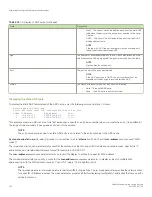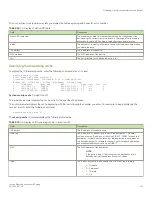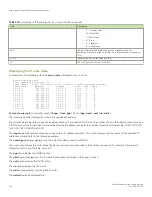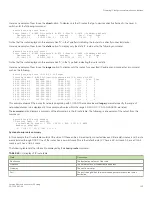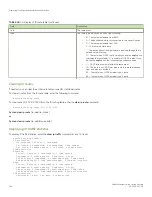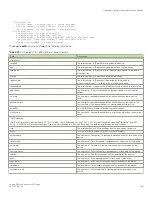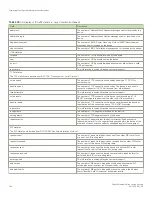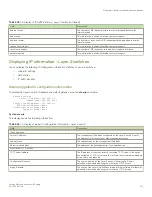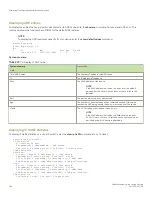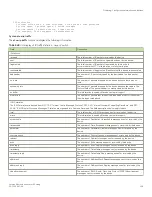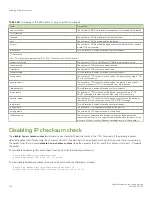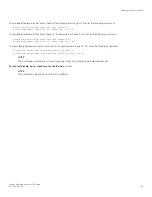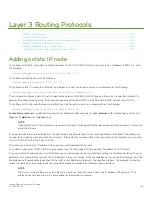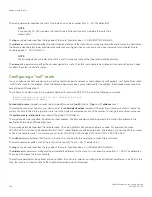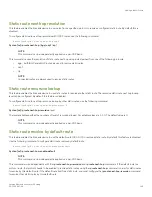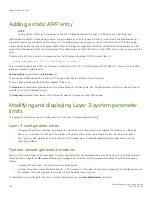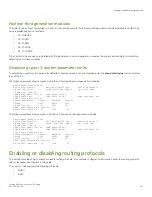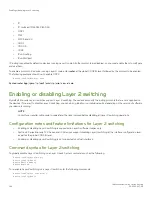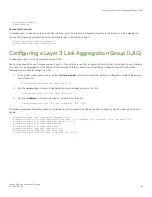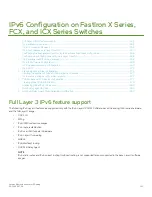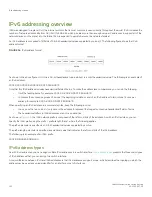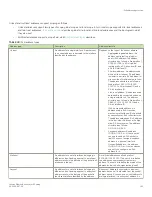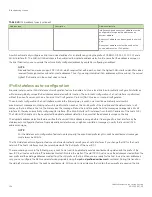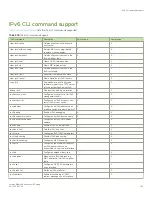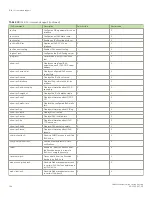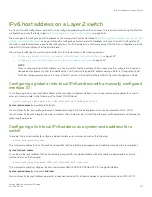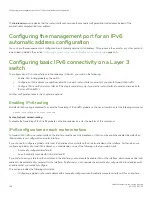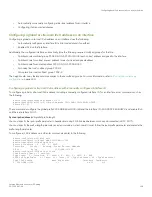
The
metric
parameter specifies the cost of the route and can be a number from 1 - 16. The default is 1.
NOTE
If you specify 16, RIP considers the metric to be infinite and thus also considers the route to be
unreachable.
The
tag
num
parameter specifies the tag value of the route. Possible values: 0 - 4294967295. Default: 0.
The
distance
num
parameter specifies the administrative distance of the route. When comparing otherwise equal routes to a destination,
the Brocade device prefers lower administrative distances over higher ones, so make sure you use a low value for your default route.
Possible values: 1 - 255. Default: 1.
NOTE
The Brocade device will replace the static route if it receives a route with a lower administrative distance.
The
name
string
parameter specifies the name assigned to a route. The static route name is descriptive and an optional feature. It does
not affect the selection of static routes.
Configuring a "null" route
You can configure the Brocade device to drop IP packets to a specific network or host address by configuring a "null" (sometimes called
"null0") static route for the address. When the Brocade device receives a packet destined for the address, the Brocade device drops the
packet instead of forwarding it.
To configure a null static route to drop packets destined for network 209.157.22.x, enter the following commands.
device(config)# ip route 209.157.22.0 255.255.255.0 null0
device(config)# write memory
Syntax:
[no] ip route
{
ip-addr
ip-mask
|
dest-ip-addr
/
mask-bits
}
null0
[
metric
] [
tag
num
] [
distance
num
]
To display the maximum value for your device, enter the
show default values
command. The maximum number of static IP routes the
system can hold is listed in the ip-static-route row in the System Parameters section of the display. To change the maximum value, use
the
system-max ip-static-route
command at the global CONFIG level.
The
ip-addr
parameter specifies the network or host address. The Brocade device will drop packets that contain this address in the
destination field instead of forwarding them.
The
ip-mask
parameter specifies the network mask. Ones are significant bits and zeros allow any value. For example, the mask
255.255.255.0 matches on all hosts within the Class C subnet address specified by
ip-addr
. Alternatively, you can specify the number
of bits in the network mask. For example, you can enter 209.157.22.0/24 instead of 209.157.22.0 255.255.255.0.
The
null0
parameter indicates that this is a null route. You must specify this parameter to make this a null route.
The
metric
parameter adds a cost to the route. You can specify from 1 - 16. The default is 1.
The
tag
num
parameter specifies the tag value of the route. Possible values: 0 - 4294967295. Default: 0.
The
distance
num
parameter configures the administrative distance for the route. You can specify a value from 1 - 255. The default is 1.
The value 255 makes the route unusable.
The last three parameters are optional and do not affect the null route, unless you configure the administrative distance to be 255. In this
case, the route is not used and the traffic might be forwarded instead of dropped.
Adding a static IP route
FastIron Ethernet Switch Layer 3 Routing
144
53-1003627-04
Summary of Contents for FastIron SX 1600
Page 2: ...FastIron Ethernet Switch Layer 3 Routing 2 53 1003627 04 ...
Page 16: ...FastIron Ethernet Switch Layer 3 Routing 16 53 1003627 04 ...
Page 20: ...FastIron Ethernet Switch Layer 3 Routing 20 53 1003627 04 ...
Page 142: ...FastIron Ethernet Switch Layer 3 Routing 142 53 1003627 04 ...
Page 150: ...FastIron Ethernet Switch Layer 3 Routing 150 53 1003627 04 ...
Page 200: ...FastIron Ethernet Switch Layer 3 Routing 200 53 1003627 04 ...
Page 214: ...FastIron Ethernet Switch Layer 3 Routing 214 53 1003627 04 ...
Page 350: ...FastIron Ethernet Switch Layer 3 Routing 350 53 1003627 04 ...
Page 476: ...FastIron Ethernet Switch Layer 3 Routing 476 53 1003627 04 ...
Page 588: ...FastIron Ethernet Switch Layer 3 Routing 588 53 1003627 04 ...

